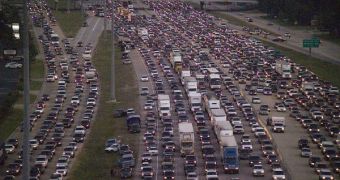Most people believe that traffic jams happen only when an accident occurs, or when a long line of cars reaches a bottleneck. Under these circumstances, the traffic naturally slows down or stops completely, but these are not the only things that cause jams. Scientists are currently studying a phenomenon called “phantom traffic jams.” Basically, it refers to those times when a driver gently steps on the breaks, but vehicles in the back are forced to do it as well, and this starts a chain reaction for miles.
This type of traffic block is not, in fact, caused by anything, and an observer situated up above could only see a line of cars stretching many miles, and standing still for hours for no apparent reason. At this point, researchers at the University of Alberta, in Canada, are working on a new theoretical approach in studying the phenomenon, which uses gas and chemical reactions inside a laboratory, rather than actual cars on freeways.
“We treat traffic as a chemically reacting gas,” Morris Flynn, who is a professor of mechanical engineering at the university, explains. The expert and his team are using small explosions and gas to simulate the development of a traffic jam. In test chambers, small explosive devices are detonated in the middle of the gas, and their effects are then analyzed. The team noticed that “ripples” spread across the gas, affecting it on long ranges.
“Once a detonation wave begins, it keeps expanding outwards. By the same token, a phantom traffic jam may start with only a handful of vehicles, but then quickly grow in scale and severity,” Flynn adds. The researcher collaborated with colleagues from the Massachusetts Institute of Technology for the new study, creating simulations for various types of roads and speed limits. The results of these tests are published online in the current issue of the scientific journal Physical Reviews E, edited by the American Physical Society.

 14 DAY TRIAL //
14 DAY TRIAL //